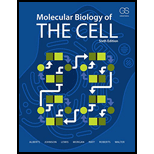
Concept explainers
A.
To explain: Why the actin filaments revolve in steps of ATP synthesis with pause in between and what does the rotation correspond to in terms of the α3β3 γ complex.
Concept introduction:
The total process of ATP synthesis is complex membrane-embedded enzyme that looks like a rounded structure with complete rotation. The rounded structure of enzyme is regarded as the F1 subunit that protrudes into the mitochondrial matrix and contains the catalytic activity of the enzyme synthase. This subunit contains various polypeptide chains. The α and β subunit of the polypeptide chain, make up the bulk of the F1 arranged alternatively in the rotational structure. The α and β subunit bind
B.
To explain: In this normal mode of operation inside the cell, total how many number of ATP molecules synthesize for each complete 360° rotation of γ subunit.
Concept introduction:
The total process of ATP synthesis is complex membrane-embedded enzyme that looks like a rounded structure with complete rotation. The rounded structure of enzyme is regarded as the F1 subunit that protrudes into the mitochondrial matrix and contains the catalytic activity of the enzyme synthase. This subunit contains various polypeptide chains. The α and β subunit of the polypeptide chain, make up the bulk of the F1 arranged alternatively in the rotational structure. The α and β subunit bind nucleotides but only the β subunits participate directly in catalysis functioning. The γ subunit breaks the symmetric position of the α3β3 hexamer, in each of the β subunits is different by virtue of its interaction with a distinct face of γ.
Want to see the full answer?
Check out a sample textbook solution
Chapter 14 Solutions
Molecular Biology of the Cell (Sixth Edition)
 Human Anatomy & Physiology (11th Edition)BiologyISBN:9780134580999Author:Elaine N. Marieb, Katja N. HoehnPublisher:PEARSON
Human Anatomy & Physiology (11th Edition)BiologyISBN:9780134580999Author:Elaine N. Marieb, Katja N. HoehnPublisher:PEARSON Biology 2eBiologyISBN:9781947172517Author:Matthew Douglas, Jung Choi, Mary Ann ClarkPublisher:OpenStax
Biology 2eBiologyISBN:9781947172517Author:Matthew Douglas, Jung Choi, Mary Ann ClarkPublisher:OpenStax Anatomy & PhysiologyBiologyISBN:9781259398629Author:McKinley, Michael P., O'loughlin, Valerie Dean, Bidle, Theresa StouterPublisher:Mcgraw Hill Education,
Anatomy & PhysiologyBiologyISBN:9781259398629Author:McKinley, Michael P., O'loughlin, Valerie Dean, Bidle, Theresa StouterPublisher:Mcgraw Hill Education, Molecular Biology of the Cell (Sixth Edition)BiologyISBN:9780815344322Author:Bruce Alberts, Alexander D. Johnson, Julian Lewis, David Morgan, Martin Raff, Keith Roberts, Peter WalterPublisher:W. W. Norton & Company
Molecular Biology of the Cell (Sixth Edition)BiologyISBN:9780815344322Author:Bruce Alberts, Alexander D. Johnson, Julian Lewis, David Morgan, Martin Raff, Keith Roberts, Peter WalterPublisher:W. W. Norton & Company Laboratory Manual For Human Anatomy & PhysiologyBiologyISBN:9781260159363Author:Martin, Terry R., Prentice-craver, CynthiaPublisher:McGraw-Hill Publishing Co.
Laboratory Manual For Human Anatomy & PhysiologyBiologyISBN:9781260159363Author:Martin, Terry R., Prentice-craver, CynthiaPublisher:McGraw-Hill Publishing Co. Inquiry Into Life (16th Edition)BiologyISBN:9781260231700Author:Sylvia S. Mader, Michael WindelspechtPublisher:McGraw Hill Education
Inquiry Into Life (16th Edition)BiologyISBN:9781260231700Author:Sylvia S. Mader, Michael WindelspechtPublisher:McGraw Hill Education





